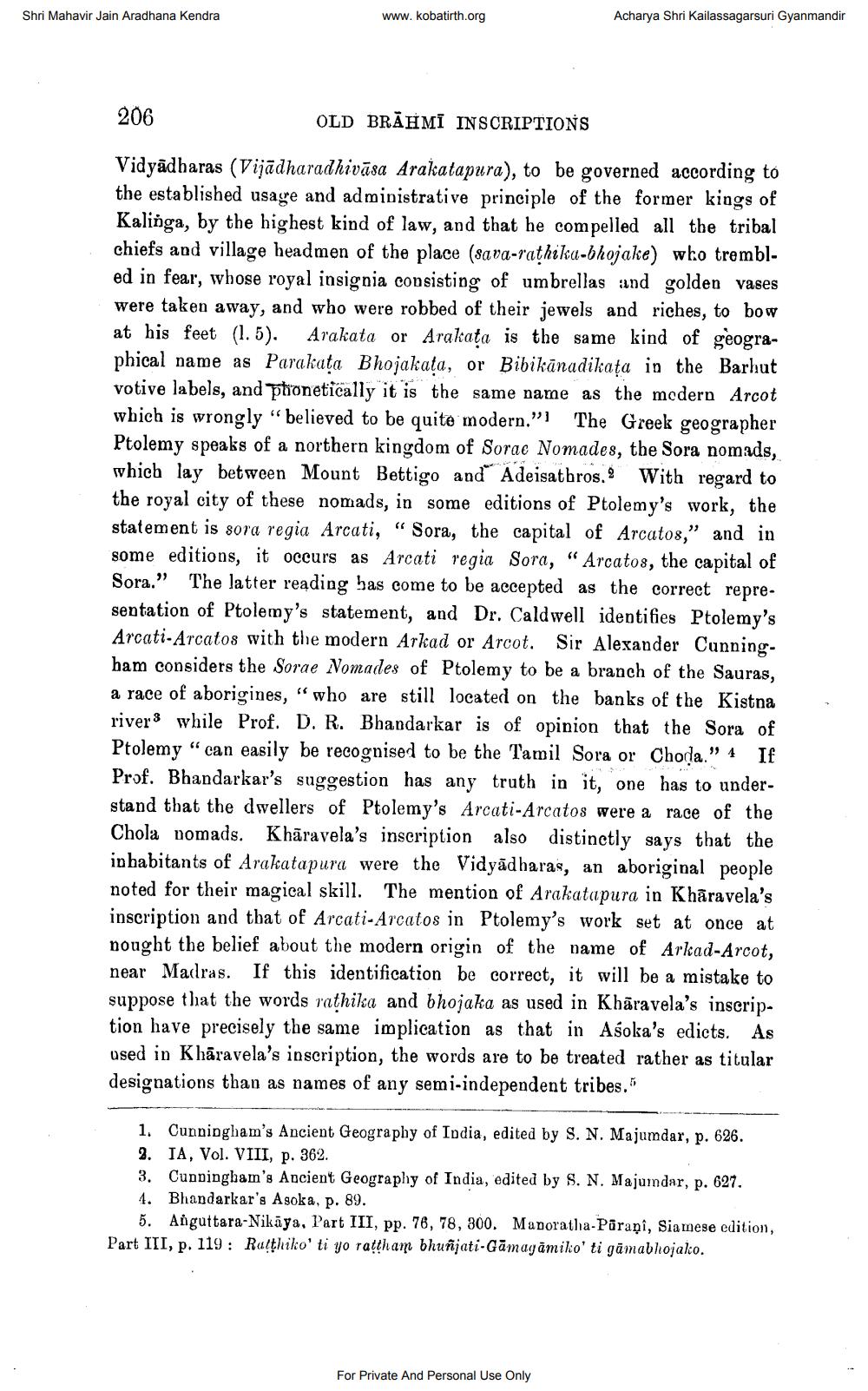________________
Shri Mahavir Jain Aradhana Kendra
www.kobatirth.org
Acharya Shri Kailassagarsuri Gyanmandir
206
OLD BRAHMI INSCRIPTIONS
Vidyādharas (Visādharadhivāsa Arakatapura), to be governed according to the established usage and administrative principle of the former kings of Kalinga, by the highest kind of law, and that he compelled all the tribal chiefs and village headmen of the place (sava-rathika-bhojake) who trembled in fear, whose royal insignia consisting of umbrellas and golden vases were taken away, and who were robbed of their jewels and riches, to bow at his feet (1.5). Arakata or Arakata is the same kind of geographical name as Parakata Bhojakata, or Bibikānadikata in the Barhut votive labels, and phonetically it is the same name as the modern Arcot which is wrongly "believed to be quite modern."} The Greek geographer Ptolemy speaks of a northern kingdom of Sorae Nomades, the Sora nomads, which lay between Mount Bettigo and Adeisat bros. With regard to the royal city of these nomads, in some editions of Ptolemy's work, the statement is sora regia Arcati, “Sora, the capital of Arcatos," and in some editions, it occurs as Arcati regia Sora, “ Arcatos, the capital of Sora.” The latter reading has come to be accepted as the correct representation of Ptolemy's statement, and Dr. Caldwell identifies Ptolemy's Arcati-Arcatos with the modern Arkad or Arcot. Sir Alexander Cunningham considers the Sorae Nomades of Ptolemy to be a branch of the Sauras, a race of aborigines, "who are still located on the banks of the Kistna river: while Prof. D. R. Bhandarkar is of opinion that the Sora of Ptolemy " can easily be recognised to be the Tamil Sora or Choda." 4 If Prof. Bhandarkar's suggestion has any truth in it, one has to understand that the dwellers of Ptolemy's Arcati-Arcatos were a race of the Chola nomads. Khāravela's inscription also distinctly says that the inhabitants of Arakatapura were the Vidyādbaras, an aboriginal people noted for their magical skill. The mention of Arakatapura in Khāravela's inscription and that of Arcati-Arcatos in Ptolemy's work set at once at nought the belief about the modern origin of the name of Arkad-Arcot, near Madras. If this identification be correct, it will be a mistake to suppose that the words rathika and bhojaka as used in Khāravela's inscription have precisely the same implication as that in Asoka's edicts. As used in Khāravela's inscription, the words are to be treated rather as titular designations than as names of any semi-independent tribes."
1. Cunningham's Ancient Geography of India, edited by S. N. Majumdar, p. 626. 2. JA, Vol. VIII, p. 362. 3. Cunningham's Ancient Geography of India, edited by S. N. Majumdar, p. 627. 4. Bhandarkar's Asoka, p. 89.
5. Anguttara-Nikāya, Part III, pp. 76, 78, 300. Maporatha-Pärani, Siamese edition, Part III, p. 119: Ratthiko' ti yo rattham bhunjati-Gāmayāmiko' ti gāmablojako.
For Private And Personal Use Only




